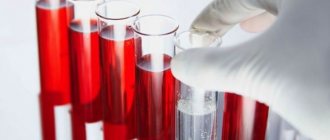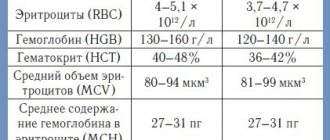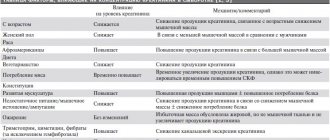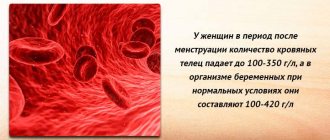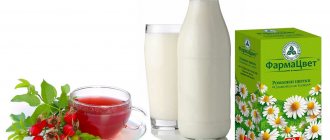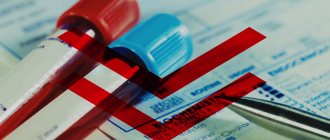Cancer indiscriminately affects both children and older people. The number of cancer patients is increasing every day. The most effective method of combating a malignant tumor is chemotherapy, which significantly increases the chances of recovery.
Chemotherapy is a serious burden on the body, which an experienced oncologist at the Yusupov Hospital will inform you about. The medical institution is one of the leading Russian centers, where not only diagnostics and treatment are carried out, but also their own clinical research in relation to cancer diseases is introduced into practice. This allows the use of chemotherapy drugs that cannot be treated in other oncology hospitals. Chemotherapy treatment is not prescribed if there is no morphological conclusion about the nature of the tumor and its type. A significant portion of cancer diagnoses require additional tests that not only confirm the cancer, but also make significant adjustments to the treatment protocol, as well as identify the sensitivity of the tumor to a specific drug.
Treatment with antitumor drugs is impossible without consequences: drugs destroy not only aggressive cells, but also healthy structures. One of the unpleasant side effects is thrombocytopenia after chemotherapy. The main danger is that any physical activity can lead to internal bleeding. Patients of the Yusupov Hospital receiving antitumor therapy are under strict medical supervision to prevent undesirable consequences that are typical during cancer treatment.
What does it mean if there are few platelets in the blood?
Platelets are blood cells without nuclei, which have a special mission in the body - they are responsible for blood clotting. If it were not for these blood platelets, the blood from the cuts and abrasions would ooze without stopping. Thanks to platelets, platelets accumulate on wounds and form a crust that stops bleeding.
When there are fewer platelets in the blood than required, even minor damage to the skin leads to intense bleeding. A decrease in platelets interferes with clot formation and leads to increased bleeding.
If the blood contains few platelets, a diagnosis of thrombocytopenia is made. This disease is extremely dangerous. It threatens not only health, but also life.
Material and research methods
The China Stroke Primary Prevention Trial (CSPPT) was designed to test the hypothesis that the combination of enalapril and FA for the prevention of first stroke is more effective than enalapril alone in adults with arterial hypertension living in China. The study included a total of 20,702 participants (mean age 60 ± 7.5 years). The enalapril plus FC group and the enalapril alone group included 10,348 and 10,354 participants, respectively.
The results of the CSPPT study showed that taking enalapril in combination with FC leads to a statistically significant reduction in the risk of stroke by 21% (hazard ratio 0.79 with 95% CI 0.68 to 0.93; p = 0.003 for log ranking criterion).
This analysis included data from 10,789 CSPPT study participants (mean age 59.5 years; 38% men without history of stroke or myocardial infarction) who were assigned to receive 10 mg enalapril and 0.8 mg FA (n =5408) or the isolated 10 mg enalapril group (n=5381).
How to diagnose thrombocytopenia
A person may not suspect the presence of thrombocytopenia for a long time, since at first it is not accompanied by any specific symptoms.
As the pathology develops, the first symptoms appear:
- bleeding time from wounds increases;
- bleeding of the nose, gums, etc. is observed;
- in women – the duration and abundance of menstrual flow increases;
- hematomas and hemorrhagic rashes appear on the skin.
Having noticed a problem repeating itself over and over again, a person goes to the doctor. Most patients presenting with such complaints are referred for a general blood test. The laboratory conducts research on several indicators, including determining the number of platelets.
Doctors are not interested in the total volume of blood cells, but in their number compared to white blood cells, red blood cells and other blood components.
Attention! If platelet levels are low, medical manipulations are dangerous because they damage the integrity of the skin and mucous membranes.
Blood for analysis is taken from a finger or a vein - it depends on the equipment of the laboratory. If questions arise, the doctor additionally prescribes a biochemical blood test. The study allows us to identify inflammatory processes, disorders in the endocrine system and water-salt balance, and other indicators.
The diagnosis of thrombocytopenia is made after a blood test for the content of proteins, carbohydrates, enzymes, pigments, and microelements. The nitrogen metabolism rate is also determined.
Blood clotting (platelet aggregation) is determined using special tests:
- According to Sukharev. For analysis, biomaterial is taken - blood from a finger, on an empty stomach. The material is placed in a special test tube, which is tilted in different directions. A stopwatch is used to measure the time until the blood loses its ability to move freely in the vessel.
- According to Lee-White. During the study, the rate of venous blood clotting is determined. Analysis - 3 ml of blood, taken on an empty stomach. Normal clotting time is considered to be 4-7 minutes (at 37°C). Blood taken for analysis is poured into three tubes heated to 37°C. They are installed with the floor tilted at an angle of 50 degrees. And then they record the time on a stopwatch and determine how many minutes it will take for the blood to clot completely. Complete clotting occurs when blood does not flow out when the tube is tilted.
Both analyzes are accurate and informative. Their implementation allows us to obtain additional information about the patient’s condition. Both methods are carried out in a hospital, since testing is carried out immediately after blood collection - due to its rapid clotting.
Indications for therapy
In fact, herbal treatment is indicated for the vast majority of patients with thrombocytopenia.
Herbs do not overload the liver and gastrointestinal tract, have virtually no side effects, do not cause drug intoxication and are sometimes more effective than all the tablets combined. Herbal medicine aimed at raising platelets is indicated in the presence of the following symptoms:
- Heavy bleeding in women during menstruation;
- Blood impurities in urine and feces;
- Excessive bleeding even from minor cuts or scrapes;
- Frequent hematomas;
- Bleeding gums;
- Frequent nosebleeds without signs of blood pressure problems;
- Even the smallest blows cause bruises and bruises.
These symptoms may indicate a lack of platelets in your blood. Of course, to confirm this diagnosis and prescribe treatment, a consultation with a doctor and tests are required. Only after this can you confidently draw up a therapeutic course and choose a herbal mixture for treatment at home.
Norm
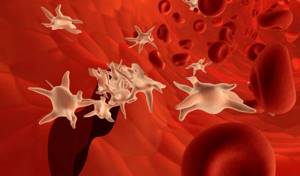
Two units of measurement are used to describe platelet levels: cells/l (units) or thousand units/μl. Normally, the number of platelets in the blood is, thousand units/μl:
- from 15 years – 200-400;
- 5-15 years – 150-450;
- 1-4 years – 150-400;
- children under one year old – 160-320.
The norm depends on gender, thousand units/μl:
- for men – 200-400;
- for women – 180-320.
During pregnancy, the indicator may drop slightly - to 150-320 thousand units / μl. During menstruation, the platelet level drops to 75–220 thousand units/μl. This situation is considered normal.
On a note! During the day, fluctuations in platelet volume within 10% are allowed. With large deviations they speak of pathology.
Deviation of platelets in one direction or another is equally dangerous. With a high level of platelets, there is a risk of blood clots; with a low volume, blood leaks through the walls of blood vessels and spontaneous formation of hematomas.
The role of platelets and the danger of thrombocytopenia
Platelets - small, flat cells without a nucleus - play a critical role in maintaining the integrity of blood vessels, preventing blood loss and maintaining normal blood clotting. They are produced by red bone marrow, and the process of their formation is controlled.
In a healthy person, the platelet count should be in the range of 150,000–400,000 per microliter. When there are not enough of them, capillary permeability increases, which is expressed in a pinpoint red rash on the skin - diapedetic hemorrhage. The vessels are left without protection, which is why their walls become thinner under the influence of damaging factors. Rashes appear on the body - small, medium and large bruises, which are combined into stripes and large spots. This is how thrombocytopenic purpura develops.
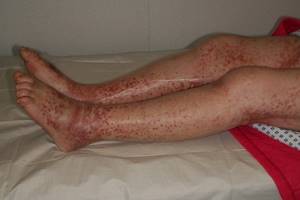
Mild thrombocytopenia is asymptomatic. There may be a tendency to nosebleeds, bruising from minor injuries, and heavier and longer periods in women.
A decrease in platelet count to 20–50 thousand per microliter is an average severity of the disease. Its sign is the appearance of a red or purple rash that occurs for no apparent reason. If the platelet count is less than 20,000/μl, the patient is at risk of severe internal bleeding and hemorrhages in the organs.
Reasons for the downgrade

A decrease in the level of blood platelets provokes various disorders in the body. In some cases, urgent treatment is necessary, in others the situation does not require medical intervention - just adjusting the diet is enough.
The condition is temporary, not dangerous, and does not require special treatment if it is caused by excessive consumption of certain foods.
A drop in platelet levels usually occurs due to:
- primary herpes;
- liver inflammation during hepatitis;
- infectious and viral diseases;
- mononucleosis;
- immunodeficiency;
- malignant tumors;
- vitamin deficiency;
- alcohol intoxication;
- pregnancy;
- Gaucher's disease;
- autoimmune conditions;
- abuse of anticoagulants and blood thinners.
Garlic, cherries, ginger, onions, and lemon help reduce platelets.
After chemotherapy
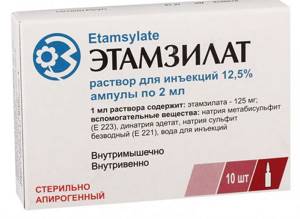
Chemotherapy effectively fights cancerous tumors. Doctors strive to select drugs that affect only harmful cells, but the entire body suffers the blow.
Due to chemotherapy, the patient loses his hair, his immunity decreases, the functioning of the gastrointestinal tract is disrupted, and the composition of the blood changes. After the procedures, leukopenia, anemia and other complications may develop. The ESR increases, the number of leukocytes and platelets decreases, and hemoglobin decreases.
After chemotherapy, it is important to quickly restore the balance of blood composition. To quickly raise platelets, the patient is prescribed:
- Medicines: etamsylate, dicion, dexamethasone, prednisone.
- Derinat is a natural preparation made from sturgeon milt.
- Vitamins. Particular emphasis is placed on Vitamins B and C.
- Microelements. It is especially important to supply the body with calcium, magnesium, and zinc.
The patient is also prescribed to eat sprouted soybeans, seeds, and nuts. Eat more fruits and dried fruits. To increase platelets, nettle is used - a tincture is made from it.
During pregnancy
During pregnancy, the level of blood platelets is not stable. If platelets are low, there is a risk of bleeding during childbirth. Treatment is usually carried out in a hospital to avoid dangerous consequences from taking medications.
To raise the level of platelets in the blood, a woman may be prescribed:
- Coagulants. These drugs make the blood thicker. Their intake in the third trimester is carried out under the supervision of a doctor and only in a hospital.
- Vitamin complexes.
- Corticosteroid hormones.
- Blood transfusion. It is carried out when the level of blood platelets drops below a minimum.
In mild cases, it is enough for a pregnant woman to adjust her diet. She needs to eat foods that increase platelets in the blood. Her diet should contain a lot of apples, bananas, chicken eggs, meat, fish, greens, and legumes.
conclusions
A subgroup of patients with arterial hypertension living in China who have a reduced platelet count and elevated blood homocysteine levels have the highest risk of stroke, but this risk is reduced by 73% with the use of FA.
If these findings are confirmed, reduced platelet counts and elevated blood homocysteine levels could serve as biomarkers to identify individuals at high risk of stroke who may benefit from FC treatment particularly.
The child has
You can guess about the reduced content of blood platelets without analysis. This is indicated by the frequent appearance of bruises, nosebleeds, red spots on the body, and bleeding gums after brushing your teeth.
After the diagnosis is made, the cause of the pathology is determined and appropriate treatment is prescribed. The problem can be caused by:
- helminthic infestation;
- eating disorder;
- anemia;
- vitamin deficiency;
- intoxication;
- infectious diseases - measles, rubella, tuberculosis.
To increase the level of platelets in the blood, the child is prescribed treatment taking into account the underlying disease. Along with taking medications, the child needs:
- provide protection from injury;
- get enough sleep;
- spend a long time on the street;
- Healthy food.
In children, when treating thrombocytopenia, the main emphasis is on nutrition. The child is given blood thinning products:
- raspberries;
- cranberries;
- cucumbers;
- tomato juice;
- citrus fruits and other products.
To increase the number of platelets in a child’s blood, his diet should contain many foods rich in vitamins A, B, C. It is necessary that the menu include legumes, melons, sea fish, eggs, rice, buckwheat, parsley, nuts, flaxseed oil , beet.
On a note! When preparing salads for children with thrombocytopenia, it is recommended to use sesame oil instead of vegetable oil.
How to raise platelet levels after chemotherapy. Nutrition and diet
In addition to therapeutic treatment, the clinic develops an individual diet, which is necessary for the restoration of the body.
Our own catering service will satisfy the most demanding patients. The dietary menu and set of permitted dishes are determined by the attending physician in accordance with the recommendations of a nutritionist.
A unique diet for patients who have low platelets after chemotherapy includes a group of foods that contain components necessary to build the supporting structure of platelets. The hospital's nutritionists recommend including foods rich in plant-based protein in your diet. Nutrition after chemotherapy should be balanced and healthy, having a beneficial effect on the circulatory system. The menu must include vegetables, fruits, berries, and herbs. It is advisable to limit animal fats, and ideally eliminate them. A worthy replacement for fat is sunflower or olive oil.
- low-fat chicken broth;
- bakery products made from rye flour;
- vegetable salads with the addition of herbs and vegetable oil;
- fish dishes (steam cutlets from low-fat fish, boiled fish);
- boiled chicken meat;
- porridges, pasta from durum wheat;
- fruit juices, compotes;
- nuts, raisins, figs.
Drugs to increase platelets
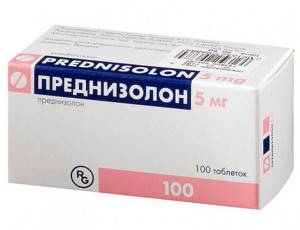
Medications are prescribed to treat thrombocytopenia. They should be prescribed by a hematologist. Self-medication leads to dangerous complications. Drug therapy for pathology involves the use of hormonal and hemostatic agents.
Commonly used drugs:
- Etamzilat. Hemostatic agent that eliminates bleeding and hemorrhage. Increases blood clotting and prevents complications. It is administered to control the hematopoietic function.
- Prednisolone. Hormonal drug. It is often prescribed to patients with cancer. Stimulates the functioning of the hematopoietic system. The drug is contraindicated during pregnancy and lactation. Not recommended for children.
- Codecor. It contains only natural ingredients. Plant extracts improve the functioning of the bone marrow, which stimulates the production of blood cells.
- Derinat. Bone marrow stimulant. It contains nucleic acids from salmon fish. Improves blood clotting. Can be given to children and elderly patients.
- Vicosol. Stimulates factors affecting blood clotting. This is an adjuvant that does not affect the number of cells.
Medications
In case of a serious decrease in platelet concentration, when it is necessary to quickly improve the patient's condition, special medications are used that raise the level of blood cells. They can only be taken as prescribed by a doctor - self-medication can lead to serious health problems.
When taking medications, it is important to follow medical recommendations and monitor the person’s well-being. You can increase platelets in the blood with the help of Prednisolone, Etamsylate, Azathioprine and immunoglobulin, and they are usually used in combination.
[media=
https://youtu.be/6f7FjnUYSCc
]
Hormonal drug Prednisolone
Prednisolone is a drug from the category of glucocorticosteroid hormones. These are synthetic substances that resemble adrenal hormones in composition. The drug is widely used in medicine to treat various diseases, including hematopoietic disorders and thrombocytopenia. It is available in the form of tablets or injections; the dosage and treatment regimen depend on the clinical course of the disease, age and characteristics of the patient’s body.
Prednisolone is incompatible with some medications, so the selection of complex therapy should be carried out by a doctor.
Prednisolone is an effective medicine, but has many contraindications and side effects. It is not used for ulcerative lesions of the gastrointestinal tract, renal failure, increased blood clotting, or chickenpox.
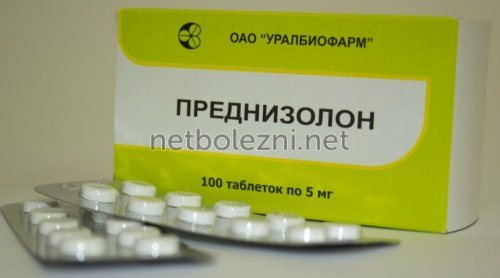
With long-term therapy, the drug can disrupt hormonal levels and the functioning of the adrenal glands, so treatment should be carried out under medical supervision.
Etamsylate tablets
A hemostatic agent that stimulates the production of platelets and their release from the bone marrow, and is used in severe cases of thrombocytopenia, when the pathological condition is accompanied by bleeding. It promotes platelet adhesion, reduces the permeability of vascular walls and increases their elasticity.
The effect occurs within 1-2 hours after using the drug, and with systemic use, the symptoms of thrombocytopenia disappear. Contraindications include bronchial asthma, malignant blood diseases, and a tendency to form blood clots. The dosage and treatment regimen depend on the severity of symptoms and characteristics of the patient’s body.
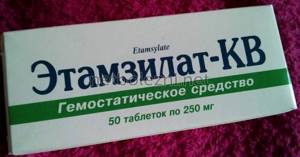
Immunoglobulin injections
Immunoglobulin is one of the most effective drugs for thrombocytopenia. It increases platelet concentration by up to 75% even in chronic disease. The drug consists of antibodies that are obtained by special processing of plasma or serum of donor blood.
Immunoglobulin injections can only be given in a medical facility to prevent allergic reactions and other side effects.
It is produced in the form of solutions for intramuscular injection; contraindications include hypersensitivity to the components of the product, allergies to protein compounds, severe disorders of hematopoietic function.
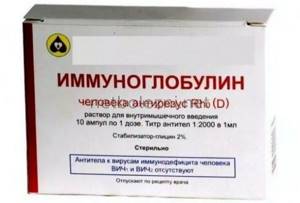
The standard dosage is 0.15-0.2 ml per kilogram of weight, but if necessary, the doctor can change the regimen. The course of treatment includes a maximum of 4 injections, which are given at intervals of 2-3 days.
Immunosuppressant azathioprine
Azathioprine belongs to the category of immunosuppressants, used in autoimmune diseases and hematopoietic dysfunction. It is available in the form of tablets, which are recommended to be taken in combination with corticosteroids and cyclosporine - these substances improve the therapeutic effect of administration. Treatment is usually long-term - at first the patient receives a large dose, after which it is gradually reduced, brought to maintenance, and when the condition improves, the drug is discontinued.
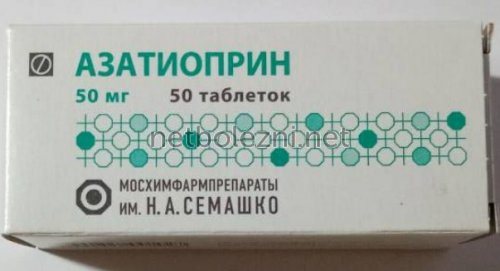
Contraindications include a decrease in the concentration of leukocytes and severe liver dysfunction, pregnancy, and individual intolerance to the components of the drug.
| A drug | Active substance | Manufacturer | price, rub. |
| Prednisolone | Prednisolone | Pharmaceutical companies from India, Ukraine, Russia, Hungary | 80 |
| Etamzilat | Etamzilat | Kyiv Vitamin Plant, Ukraine | 190 |
| Immunoglobulin | Immunoglobulin | Biopharma Plasma, Ukraine | 1250 |
| Azathioprine | Azathioprine | Hexal, Italy | 400 |
Medicines used to treat thrombocytopenia are considered potent and can only be used as prescribed by a doctor. In addition, if there is a serious decrease in indicators, it is necessary to undergo complex treatment, establish and eliminate the cause of the pathology. Many diseases accompanied by thrombocytopenia are extremely dangerous and can lead to severe complications and death.
What foods increase platelets in the blood?

The easiest way to treat thrombocytopenia is to eat foods that can increase the number of platelets in the blood. Such products contain a lot of iron and vitamins.
Eating the following will help increase platelets:
- Liver. It contains a lot of iron, so it can very quickly raise the level of blood platelets. Beef, pork, chicken liver is suitable. We need the liver of grain-fed animals and birds. Poor-quality animal feed deposits many toxins in the liver that are harmful to humans. It is recommended to boil, bake or steam the liver.
- Buckwheat porridge. It is useful not only for thrombocytopenia, this porridge also increases hemoglobin and red blood cells. Buckwheat contains a lot of iron, protein and vitamins. It is recommended to give preference to green buckwheat. Along with buckwheat, you can eat millet, rice and oatmeal.
- Dairy products. It is recommended to eat foods rich in calcium - milk, yogurt, hard cheese, sour cream, yogurt, cottage cheese.
- Egg yolk. It contains a lot of cholesterol, which is why people with atherosclerosis were previously prohibited from eating it. Research has shown that the yolk contains substances involved in the construction of blood cells. It also contains albumin, a component present in blood plasma. Today, scientists believe that yolks should be included in the diet of people with thrombocytopenia.
- Kiwi. By eating 2 fruits a day, you can quickly get rid of thrombocytopenia. Kiwi contains many B vitamins, strengthens the immune system and increases hemoglobin.
- Pitahayas. The Asian fruit is consumed when on vacation in China, Thailand, Vietnam, and other Asian countries. You can bring fruit, but they don’t last long. In Russia, it is difficult to buy pitahaya and it is expensive.
- Papaya leaves. Restores the balance of blood composition. A decoction is made from the leaves, which is drunk in the mornings and evenings. A single dose is a tablespoon.
On a note! When consuming dairy products, you must avoid smoking, alcohol and soda to prevent calcium leaching.
Prerequisites for the study
In China, stroke is considered the leading cause of death, and in other countries overall, stroke is the 2nd most common cause of death.
Primary stroke prevention appears to be especially important since 77% of all strokes are first strokes.
There remains uncertainty regarding the effectiveness of folic acid (FA) for the primary prevention of stroke due to the limited and inconsistent data available.
Most RCTs were designed to evaluate the effectiveness of FC for secondary prevention of cardiovascular disease and reported no benefit, although individual studies and meta-analyses suggested a specific reduction in the risk of stroke.
Platelets play an important role in the pathogenesis of vascular diseases. Previous studies have examined the role of platelets in the acute phase of stroke. Only one prospective study has assessed the association between platelet count and risk of stroke, in the absence of studies assessing the association between platelet count and risk of first stroke.
Vitamins
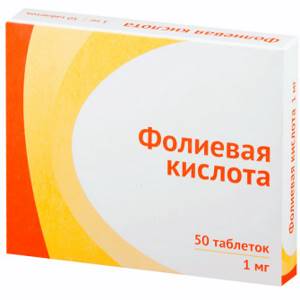
Certain vitamins, microelements and acids have a positive effect on the maturation of blood cells. These substances can be obtained from foods or together with special medications.
Recommended vitamins and microelements:
- Vitamin B12. You can buy a vitamin preparation. There is also a lot of it in beef liver - it should be eaten at least three times a week, in seafood, fish, dairy products and breakfast cereals. There is especially a lot of B12 in multigrain and corn flakes.
- Vitamin K. Activates bone marrow, improves blood clotting. Prevents hemorrhagic complications that often occur with thrombocytopenia. There is a lot of vitamin K in carrots, tomatoes, legumes, potatoes, and broccoli.
- Folic acid. A pharmaceutical preparation or products containing a lot of it will help provide the body with folic acid. It is recommended to eat liver - beef and pork, asparagus, lettuce, melons, cucumbers, rye and wheat flour. There is a lot of folic acid in beets. But it is not advisable to cook it. It is also recommended to drink beet juice on an empty stomach.
- Iron. Pharmacy preparations Ferrumlek or Fenyuls are recommended. Meat, offal, fruits and vegetables, berries, dried mushrooms, seafood, and freshly squeezed juices also help to compensate for the lack of iron.
Platelet Boosters and Low Platelet Products
Products that stimulate blood platelets in the bloodstream are needed when they suddenly begin to clot poorly.
Platelets are blood cells whose main function is to maintain normal levels of blood clotting. Font Color = #38B0DE=https://www.youtube.com/watch?v=- Proud Gifts.
They are very important for the body, and low levels can lead to serious problems. Therefore, it is not recommended to regulate the situation on your own - you should consult a doctor as soon as the platelet count decreases.
A decrease in platelet count is called thrombocytopenia.
There are a number of reasons that can cause this problem:
- Development of autoimmune diseases, including HIV infection.
- Development of viral diseases.
- Development of blood diseases.
- Severe poisoning.
- Chemotherapy.
- Some types of drugs.
- Pregnancy.
- Food allergies.
Pregnancy and chemotherapy differ from this area in terms of the development and course of thrombocytopenia.
Thrombocytopenia develops regularly during pregnancy, especially if the woman has pre-existing conditions for this disease. Acute cases can be dangerous for the expectant mother due to high blood loss caused by impaired blood clotting.
However, thrombocytopenia in pregnant women:
- does not become an obstacle to the birth of a child;
- does not become an obstacle to spontaneous childbirth.
It can be dangerous, just in case.
- Abortion;
- C-section.
After childbirth, the platelet count in a healthy woman usually returns to normal. It can also be helped by eating right.
Chemotherapy is one of the most important tools in the fight against cancer, which is often impossible to avoid, but it has a detrimental effect on platelet levels, sometimes to the extent that it becomes necessary to use platelets for blood transfusions.
It is important that the patient follows certain rules until the end of treatment:
Pay special attention to handling piercing and cutting objects. Use gastrointestinal protectors
Use a soft toothbrush. Use an electric razor. Do not take aspirin or medications containing aspirin.
This will allow for a safe passage during difficult times.
Symptoms and consequences
Symptoms of thrombocytopenia are clearly visible.
It includes
- Lots of bumps and bruises.
- Significant increase in menstruation, fluid loss.
- Blood in stool and urine.
- Blood on the gums while brushing your teeth.
- Problems with blood clotting even with minor abrasions.
- Frequent nosebleeds.
If these problems are identified, it is important to see a doctor as soon as possible - it is much easier to control thrombocytopenia and increase the blood pressure of these organs in the early stages. In addition, these symptoms may be signs of other even more serious diseases.
In addition, these symptoms may be signs of other even more serious diseases.
Thrombocytopenia should not be treated lightly.
The onset of the disease can have such consequences as, for example,
- Thrombosis;
- Strokes;
- Heart attacks;
- Kidney disease;
- increased blood pressure;
- heavy bleeding.
This can be fatal, as even the smallest injury causes serious bleeding problems.
Possibilities of increasing platelet count
An independent increase in platelet count is possible only at the earliest stage of thrombocytopenia. If the disease develops more progressively, you should consult a doctor.
This is what we should do at home:
- Add a large amount of black foods to your diet: liver, buckwheat, pomegranates. Increase your consumption of fruits and vegetables.
- Fewer foods that can cause blood thinning: Citrus fruits, ginger, raspberries, olive oil.
A diet with elevated blood platelets, which cause thickening of the blood or risk of blood clots, allows the presence of these foods in the diet. - Only caffeine and alcohol.
- Excluding fried and fatty foods.
In some cases, thrombocytopenia is caused by a lack of vitamins such as B12.
Taking vitamin complexes in which they are present can help overcome this problem.
https://www.youtube.com/watch?v=VWXSRQ2F-YYY
The most commonly used medications in this case include the following:
- Prednisolone.
- Itamsilat.
- Codecor.
- Vikasol.
- Derinat.
- Thromboetin.
It is important to remember that many of these drugs are used in combination or have side effects. All prescriptions for treatment must be written by a doctor
Folk remedies

With minor deviations in the platelet count, you can limit yourself to adjusting the diet and folk remedies. Recipes for increasing platelets are prepared from natural and inexpensive products.
Recipes for increasing platelets in the blood using folk remedies:
- Nettle. This recipe is effective after chemotherapy. Take 5 ml of nettle juice and mix with 50 ml of milk. Take three times a day, before meals. Course – 2 weeks.
- Oak bark. 1 tbsp. l. pour a glass of boiling water over the raw materials and leave for 2 hours. Helps with bleeding gums and wounds.
- Honey and lemon. This is a means to improve blood composition and strengthen the walls of blood vessels. Mix the ingredients in equal parts and consume a tablespoon in the morning. To enhance the effect, add sesame or flaxseed oil.
- Pomegranate juice. For drinking, use diluted juice in a 2:1 ratio. People with stomach diseases should not drink without eating first.
Prevention
A healthy lifestyle and proper nutrition help prevent thrombocytopenia. Prevention of this pathology is almost no different from the prevention of most vascular disorders and cardiac pathologies.
Measures to prevent thrombocytopenia:
- stop drinking alcohol and smoking - these bad habits lead to bone marrow damage and decreased platelet formation;
- exercise regularly, but avoid unnecessary stress;
- strengthen the body and stimulate the immune system;
- maintain a sleep and rest schedule;
- Drink enough clean water - at least 2 liters per day.
A low platelet count is a dangerous condition that, if left untreated, can lead to serious complications. By diagnosing the pathology in a timely manner, you can quickly eliminate it. In some cases, it is enough to adjust your diet.
What can you do
How can you quickly increase platelets in the blood? First of all, you should start adjusting your diet and lifestyle.
Take enough vitamins. If necessary, take special multivitamin complexes prescribed by your doctor.
Among your “favorites” should be:
- Vitamin K, which normalizes the process of hematopoiesis and blood clotting, and also has a powerful anti-inflammatory effect. It helps to quickly “raise” platelets in the blood, but you shouldn’t get too carried away with it: it is advisable to consume only foods enriched with it;
- Folic acid, which is not without reason prescribed to all planning and pregnant women. It plays a decisive role in the process of cell proliferation, renewing and restoring them. A low amount of it in the body can lead to thrombocytopenia;
- Polyunsaturated fatty acids Omega-3 and Omega-9, which have anti-inflammatory and immunomodulatory properties.
Load up on the following foods:
- Broccoli;
- Spinach;
- Asparagus;
- Cabbage (white + sea cabbage);
- Chicken or quail eggs;
- Beef or veal liver;
- Whole grain porridge;
- Citrus fruits (oranges);
- Grenades;
- Fish (sea and river, preferably fatty);
- Walnuts;
- Linseed oil.
gold standard
Gluten is another “enemy” of your body, especially if you suffer from hypersensitivity to it. Such reactions cause autoimmune disorders - celiac disease and enteropathy, which negatively affect the volume and production of blood cells.
Get a special test, and if it reveals a sensitivity to gluten, you will have to completely eliminate the corresponding food from your diet.
Pay attention to the need for basic physical activity in your case. It is not at all necessary to sign up for a gym and start working out at a professional level.
Walking or jogging, as well as daily home exercises, will be enough for you.
Be sure to regulate your sleep and rest schedule. You should sleep at least 7-8 hours a day, and it is better to go to bed before midnight. Take care of yourself, communicate with your doctor and be healthy!



